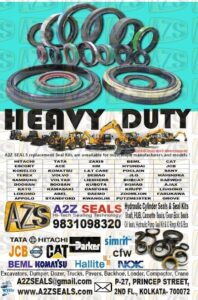NOK Seal Design: Precision-engineered, high-performance seals ensuring superior reliability and durability in diverse applications. Elevate your sealing solutions today!

Also explore the best quality Seal Kits & Oil Seal, CFW Oil Seals, NOK Oil Seals, and Crane Seal Kits.
Download A2Z Seal Kits Catalog
General studies of Seals 4
Design and Construction:
Basic Design Principles:
The fundamental design principles of oil seals revolve around creating a secure and efficient barrier. This includes considerations for lip geometry, spring configurations, and contact pressures to ensure optimal sealing performance.
Factors Influencing Design:
Several external factors influence oil seal design, including temperature variations, pressure levels, and operating speeds. Understanding these factors is crucial to designing seals that can withstand diverse and demanding conditions. Also see NOK Seal Design.
Types of Seals:
Oil seals come in various types, each tailored to specific applications. Lip seals are common in rotary applications, mechanical seals are used in high-performance scenarios, and other specialized variations cater to unique operational requirements.
Material Selection:
Choosing the right materials for oil seal construction is a delicate balance between flexibility, resilience, and chemical resistance. The selection process involves considering the specific demands of the application and the characteristics of the fluids involved.
Functionality and Working Principles:
Mechanism of Oil Sealing:
The mechanism behind oil sealing involves creating a physical barrier between moving and stationary components. This is typically achieved through the dynamic interaction of the seal lip with the rotating shaft, ensuring a tight and effective seal.
Interaction with Lubricants:
Oil seals work in conjunction with lubricants to maintain an optimal operating environment. Understanding the synergy between seals and lubricants is essential for enhancing performance and extending the lifespan of machinery.
Factors Affecting Sealing Efficiency:
Several factors influence the efficiency of oil seals, including surface finish, shaft speed, and temperature. An in-depth understanding of these variables is crucial for designing seals that perform reliably under diverse conditions. Also see NOK Seal Design.
Performance Testing and Analysis:
Laboratory Testing Methods:
Laboratory testing is essential for assessing the performance of oil seals under controlled conditions. Various methods, including leak tests, friction tests, and endurance tests, provide valuable data for evaluating the effectiveness of seals.
Evaluation of Factors:
Factors such as wear, friction, and temperature play pivotal roles in the performance of oil seals. Rigorous evaluation and analysis of these factors contribute to the development of seals that can withstand the challenges of real-world applications.
Statistical Analysis:
Statistical analysis of performance data allows for a quantitative assessment of oil seal behavior. This approach provides insights into the variability of performance under different conditions and aids in the identification of trends and patterns. Also see NOK Seal Design.
Failure Analysis:
Common Failure Modes:
Despite their critical role, oil seals are susceptible to various failure modes. Common issues include wear, degradation, and incorrect installation, each of which can compromise the effectiveness of the seal.
Root Causes of Failures:
Understanding the root causes of failures is essential for implementing effective preventive measures. Whether due to material fatigue, inadequate design, or external factors, addressing these root causes is key to enhancing the reliability of oil seals.
General studies of Seals 1 : Sealing
General studies of Seals 2 : Sealant
General studies of Seals 3 : Metric Shaft Seal
General studies of Seals 4 : Seal Design
General studies of Seals 5 : Components
Strategies for Prevention:
Implementing preventive strategies is crucial for mitigating the risk of oil seal failures. This may involve improvements in material selection, design enhancements, and adherence to proper installation and maintenance practices.
